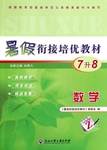题目内容
Mary _________be late, so don’t wait for her
- A.would
- B.can
- C.should
- D.may
D
考查情态动词。句意“玛丽可能会迟到,因此不要等她了。”would表示意愿;can表示的可能性比较大;should“应该”;may“也许”。故选D。
考查情态动词。句意“玛丽可能会迟到,因此不要等她了。”would表示意愿;can表示的可能性比较大;should“应该”;may“也许”。故选D。

练习册系列答案
 新课标快乐提优暑假作业陕西旅游出版社系列答案
新课标快乐提优暑假作业陕西旅游出版社系列答案 暑假衔接培优教材浙江工商大学出版社系列答案
暑假衔接培优教材浙江工商大学出版社系列答案
相关题目
